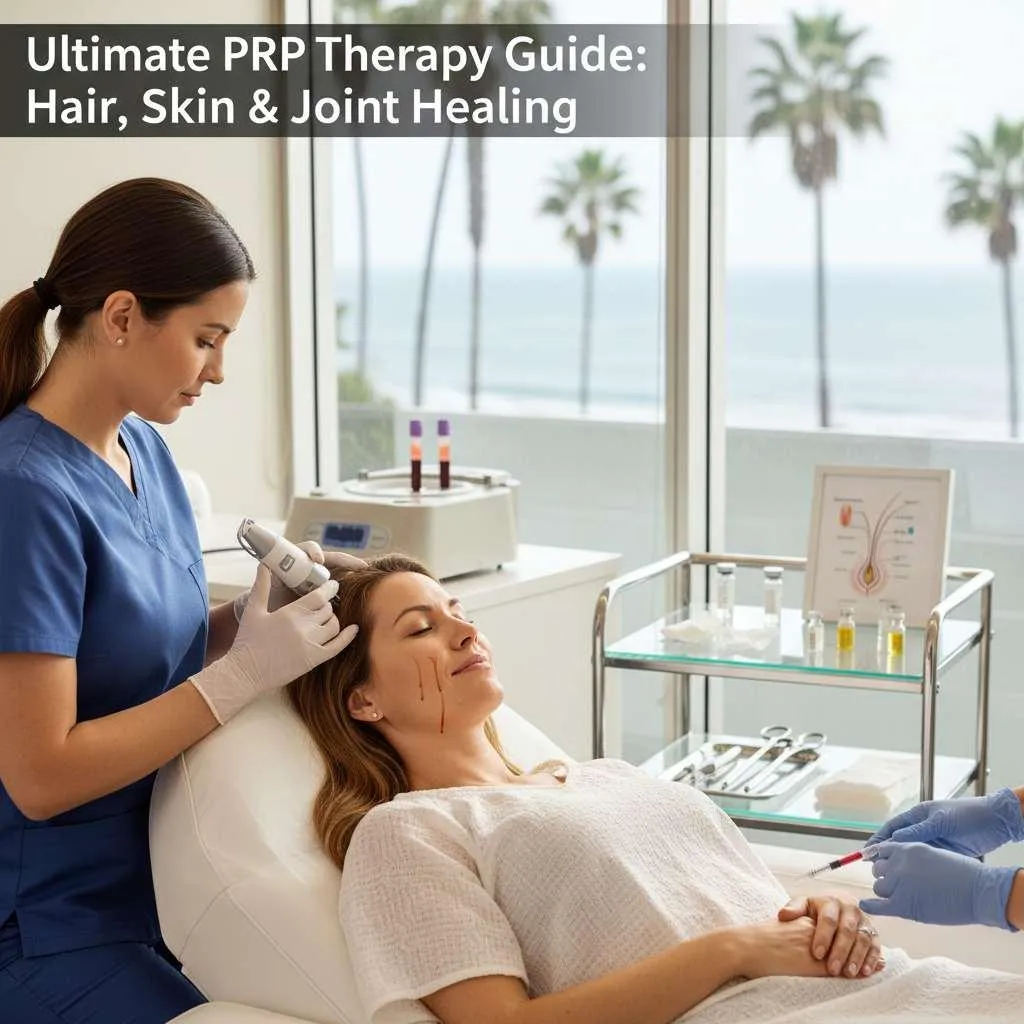
Ultimate PRP Therapy Guide: Hair, Skin & Joint Healing
Platelet-Rich Plasma (PRP) Therapy is a medical procedure that uses your own blood to heal and regenerate tissues. It concentrates platelets and growth factors to repair damaged areas, reduce inflammation, and promote new cell growth.
This treatment is popular in fields like orthopedics, sports medicine, and aesthetic dermatology. It helps with joint pain, tendon injuries, hair loss, and skin aging. As an autologous treatment, it comes from your body. This reduces the risk of side effects and makes it a safe choice for many.
This guide explains PRP Treatment in detail. Whether you are looking for PRP Therapy in Temecula for knee pain, thinning hair, or smoother skin, this article provides clear information.
What Exactly is Platelet-Rich Plasma Therapy?
Platelet-Rich Plasma Treatment uses your blood to promote healing. Blood has red cells, white cells, platelets, and plasma. Platelets help with clotting and contain Growth Factors. These proteins include:
Platelet-Derived Growth Factor (PDGF)
Transforming Growth Factor-beta (TGF-β)
Vascular Endothelial Growth Factor (VEGF)
Epidermal Growth Factor (EGF)
Insulin-like Growth Factor (IGF)
These proteins repair tissues, reduce swelling, and grow new cells. The therapy concentrates these platelets into a solution often called “liquid gold” for its color and healing power.
To create PRP, a doctor draws 10 to 60 milliliters of your blood. A machine spins the blood to separate platelets and plasma. The concentrated Platelet Concentrate Therapy is injected into areas like joints or the scalp.
In orthopedics, it treats knee pain from osteoarthritis or shoulder pain from rotator cuff issues. In aesthetics, it supports skin rejuvenation and hair restoration. According to the National Institutes of Health (NIH), studies like one in the Journal of Orthopaedic Research showed 68% of knee osteoarthritis patients had less pain after PRP injections.
How Does the Mechanism of PRP Work?

PRP Therapy works by boosting your body’s healing process. Healing happens in three distinct stages:
Inflammatory Phase: Cytokines and growth factors draw immune cells to clear damaged tissue. This reduces swelling.
Proliferative Phase: This stage grows new tissue, like cartilage in joints or collagen in skin.
Remodeling Phase: This strengthens the new tissue for lasting results.
PRP’s effects depend on the treated area:
For Osteoarthritis: It reduces swelling and repairs cartilage. A 2024 study in Arthroscopy found a 40% pain reduction in patients with mild osteoarthritis.
For Tendon Injury: Conditions like Tennis Elbow or Achilles Tendinopathy see improved healing.
For Hair Loss: It wakes up dormant follicles for thicker hair.
For Skin: It boosts collagen stimulation to smooth acne scars.
What Are the Variations of PRP?
PRP comes in different forms to match specific needs:
Leukocyte-Rich PRP (LR-PRP): This has more white blood cells. It helps with tendon repair in cases like tennis elbow. The extra white cells can cause short-term swelling but aid chronic tendon healing.
Leukocyte-Poor PRP (LP-PRP): This has fewer white cells, reducing swelling after injection. It is better for joint injections, like osteoarthritis. A 2022 study in Regenerative Medicine showed LP-PRP cut post-injection pain by 25%.
Doctors choose the type based on your condition. The centrifuge is adjusted to concentrate platelets 3 to 5 times higher than normal blood.
How is the Procedure Performed?
The PRP procedure usually takes 30 to 90 minutes and involves these steps:
Blood Draw: A doctor draws 10 to 60 milliliters of blood from your arm. Calcium Chloride is added to stop clotting.
Centrifugation: A specialized centrifuge spins the blood to separate platelets and plasma using a blood collection kit.
Injection: PRP is drawn into a syringe and injected. Ultrasound guides joint injections for accuracy, while small scalp injections are used for hair restoration.
Comfort: Numbing cream or anesthesia reduces pain, which is usually mild.
You can resume daily tasks soon, but avoid hard exercise for 48 to 72 hours. A study in Clinical Orthopaedics and Related Research showed ultrasound-guided injections improved results by 30%.
What Are the Major Uses of PRP?
PRP works for many medical and aesthetic needs.
Orthopedic and Medical Uses
Knee: Reduces swelling and repairs cartilage. A 2024 study in Sports Medicine showed 60% of patients had better mobility after 2 to 3 sessions.
Shoulder: Treats rotator cuff issues by building collagen to heal tendons.
Hip: Helps soft tissue injuries like labral tears or muscle strain.
Aesthetic and Cosmetic Uses
Skin Rejuvenation: PRP with microneedling (Vampire Facial) boosts collagen. A 2023 study in The Journal of Cosmetic Dermatology found 80% of patients had smoother skin after three sessions.
Hair Restoration: Helps androgenic alopecia by promoting thicker hair. A 2021 study in Dermatologic Surgery showed 65% better hair density after four sessions.
Who is a Good Candidate for PRP?

Good candidates generally include:
Adults with joint pain, tendon injury, or ligament sprains.
People with hair loss or skin issues like fine lines.
Healthy individuals without major health issues.
However, PRP isn't for everyone. To verify if you are eligible based on your history, reviewing specific PRP therapy candidacy requirements is a smart next step.
You should avoid PRP if you have blood disorders, active infections, pregnancy, or certain cancers.
Expected Outcomes and Timeline
How long PRP results last depends on the area treated:
Knee/Hip: Pain relief starts in 2 to 4 weeks. Full benefits show at 3 to 6 months.
Hair: Hair growth shows at 3 to 6 months and peaks at 12 months.
Skin: Texture enhancement starts in weeks, with collagen peaking at 3 months.
Soreness fades quickly. You can walk after joint injections, but avoid heavy exercise for 5 to 7 days.
Costs and Insurance Considerations
The cost of PRP depends on the treatment type and area:
Orthopedic: $500 to $2,000 per session.
Hair Restoration: $400 to $1,500 per session.
Skin Rejuvenation: $300 to $1,200 per session.
Insurance rarely covers injectable therapy for aesthetic use, though some orthopedic cases may get partial coverage. It is helpful to understand the breakdown of PRP injection costs before booking to plan your budget.
Comparison: PRP vs. Alternatives
Stem Cell Therapy: Regenerates more tissues but is much costlier and more invasive.
Cortisone: Offers quick, short-term relief but may weaken tissues over time.
Surgery: Helps severe cases but requires long recovery times.
A 2023 study in Regenerative Medicine highlighted PRP’s lower risk profile compared to stem cells, making it a preferred middle-ground option.
Why Choose LeVogue Med Spa in Temecula?
We offer expert PRP therapy tailored to your needs. Our team includes trained aesthetic injectors and specialists who use FDA-classified equipment for safe, precise injections.
Our PRP clinic in Temecula stands out for:
Expert Facial Rejuvenation: Platelet-rich plasma therapy for facial restoration Temecula is designed to give Temecula residents smoother, youthful skin with clinically proven results. This treatment targets fine lines, texture issues, and overall skin vitality.
Targeted Tendon Recovery: PRP autologous treatment for tendon repair Cary provides Cary-area patients with specialized care to naturally heal tendon injuries and restore mobility. It’s ideal for athletes or anyone recovering from chronic tendon issues.
Modern Facility: Our center ensures comfort, advanced equipment, and a safe, sterile environment for all PRP procedures, from hair restoration to joint therapy.
High Patient Satisfaction: Many patients notice visible improvements after just a few sessions, benefiting from our personalized, expert care and evidence-based PRP protocols.
Frequently Asked Questions
How does Platelet Therapy for Recovery function?
It uses your blood’s platelets to repair tissues and reduce swelling. This helps joints, skin, or hair heal naturally.
Is PRP covered by insurance?
Insurance rarely covers PRP. Cosmetic uses are out-of-pocket. Some orthopedic treatments may get partial coverage. According to the American Academy of Orthopaedic Surgeons, coverage policies vary significantly, so always check with your provider.
How painful are the injections?
Pain is mild, similar to a routine shot. Numbing cream reduces discomfort, and soreness typically fades within days.
What are signs of improvement?
Less pain, better joint movement, thicker hair, or smoother skin are key signs of success. Results typically start to show in weeks to months.
Who is not eligible for this therapy?
Avoid PRP if you have blood disorders, active infections, are pregnant, or have certain cancers.
Conclusion
Platelet-Rich Plasma Procedure is a safe, versatile treatment. It helps with orthopedics, sports medicine, and aesthetic medicine. You can treat joint pain, tendon injuries, hair loss, or skin issues. Results take time but last with proper care. For the best outcomes, work with a skilled provider.
Ready to try PRP therapy? Contact LeVogue Med Spa to book your consultation today.

